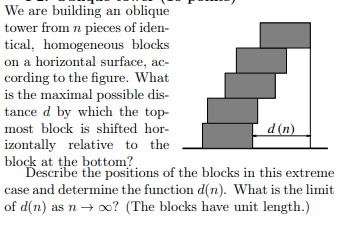We are building an oblique tower from n pieces of iden- tical, homogeneous blocks on a horizontal surface, ac- cording to the figure. What is the maximal possible dis- tance d by which the top- most block is shifted hor- d (n) izontally relative to the block at the bottom? Describe the positions of the blocks in this extreme case and determine the function d(n). What is the limit of d(n) as n → ? (The blocks have unit length.)
We are building an oblique tower from n pieces of iden- tical, homogeneous blocks on a horizontal surface, ac- cording to the figure. What is the maximal possible dis- tance d by which the top- most block is shifted hor- d (n) izontally relative to the block at the bottom? Describe the positions of the blocks in this extreme case and determine the function d(n). What is the limit of d(n) as n → ? (The blocks have unit length.)
Chapter3: Functions
Section3.3: Rates Of Change And Behavior Of Graphs
Problem 2SE: If a functionfis increasing on (a,b) and decreasing on (b,c) , then what can be said about the local...
Related questions
Topic Video
Question
We are building an oblique tower from n pieces of identical, homogeneous blocks on a horizontal surface, according to the figure. What is the maximal possible distance d by which the topmost block is shifted horizontally relative to the block at the bottom?
Describe the positions of the blocks in this extreme case and determine the function d(n). What is the limit of d(n) as n → ∞?
(The blocks have unit length.)

Transcribed Image Text:We are building an oblique
tower from n pieces of iden-
tical, homogeneous blocks
on a horizontal surface, ac-
cording to the figure. What
is the maximal possible dis-
tance d by which the top-
most block is shifted hor-
d (n)
izontally relative to the
block at the bottom?
Describe the positions of the blocks in this extreme
case and determine the function d(n). What is the limit
of d(n) as n → o? (The blocks have unit length.)
Expert Solution
This question has been solved!
Explore an expertly crafted, step-by-step solution for a thorough understanding of key concepts.
Step by step
Solved in 2 steps

Knowledge Booster
Learn more about
Need a deep-dive on the concept behind this application? Look no further. Learn more about this topic, advanced-math and related others by exploring similar questions and additional content below.Recommended textbooks for you

